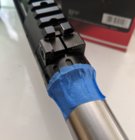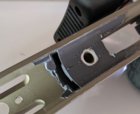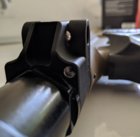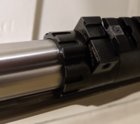More about the Barloc:
Some people saw Barloc equipped rifles have a POI shift after hitting their barrel but it was an improper installation causing that. Some people were using shouldered barrels that were not cut to the right dimension. That allowed the Barloc tensioner to bottom out before creating enough tension between the coned surfaces. You could do the same thing with a barrel nut Barloc but not if you followed the instructions.
I have come up with a trick to make the tricky part of install easy:
You are supposed to tighten the barrel shoulder or barrel nut enough to open the slot in the tensioner as wide as the barrel nut wrench. What I do is remove the socket head capscrew from the tensioner, screw it in from the other side, put a washer inside the slot and use the capscrew to push against the washer and spread the tensioner as wide as the barrel nut wrench. After that I can screw everything together finger tight, remove the capscrew and washer then put back the capscrew in the right side and tension as normal.
That method leaves a gap between the sides of the tensioner so all of the tensioner force is securing the barrel, not just bottoming out. Being able to do it finger tight makes it a lot easier to control headspace and be more consistent.
Since I could not do the precision work I wanted to do to square my receiver face to my receiver threads, the Barloc became a key component of the build. It's expensive but I didn't have to buy an action wrench so that makes it more reasonable. It's not just a fancy recoil lug/barrel nut.
Some people saw Barloc equipped rifles have a POI shift after hitting their barrel but it was an improper installation causing that. Some people were using shouldered barrels that were not cut to the right dimension. That allowed the Barloc tensioner to bottom out before creating enough tension between the coned surfaces. You could do the same thing with a barrel nut Barloc but not if you followed the instructions.
I have come up with a trick to make the tricky part of install easy:
You are supposed to tighten the barrel shoulder or barrel nut enough to open the slot in the tensioner as wide as the barrel nut wrench. What I do is remove the socket head capscrew from the tensioner, screw it in from the other side, put a washer inside the slot and use the capscrew to push against the washer and spread the tensioner as wide as the barrel nut wrench. After that I can screw everything together finger tight, remove the capscrew and washer then put back the capscrew in the right side and tension as normal.
That method leaves a gap between the sides of the tensioner so all of the tensioner force is securing the barrel, not just bottoming out. Being able to do it finger tight makes it a lot easier to control headspace and be more consistent.
Since I could not do the precision work I wanted to do to square my receiver face to my receiver threads, the Barloc became a key component of the build. It's expensive but I didn't have to buy an action wrench so that makes it more reasonable. It's not just a fancy recoil lug/barrel nut.
















